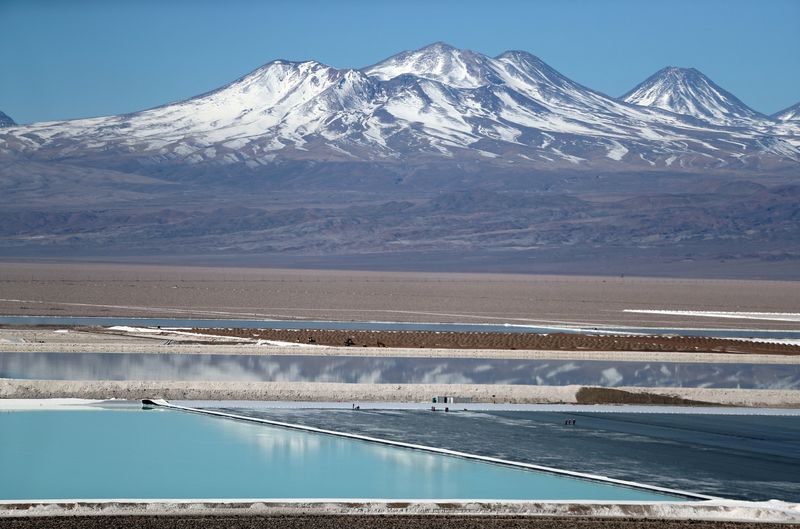By Andy Home
LONDON (Reuters) - High-flying lithium has come crashing back to earth.
A super-charged two-year rally, which saw Chinese spot lithium carbonate prices rise by tenfold, went into brutal reverse over the first part of this year. The spot price slumped by 70% between November and its low point in April.
The battery metal was knocked off its heights by early-year weakness in China's electric vehicle (EV) market, still by some margin the world's largest.
The temporary demand hit rippled back up through the Chinese battery chain, generating a collective destocking cycle and killing the spot market.
The slump in China's spot price dragged down the whole lithium pricing chain from spodumene concentrate to hydroxide, albeit to highly varying degrees.
The price impact looks outsize to what was a short-term mismatch of supply and demand in the Chinese domestic market, where the spot price is already bouncing back hard.
But lithium's roller-coaster ride highlights the important role China's spot market and the Wuxi futures exchange play in the fast-growing industry's price discovery process.
PRICE SLUMP FOR SOME, BUT NOT FOR ALL
The Chinese spot lithium carbonate market is a small and volatile component of the global lithium pricing structure, and price signals can be extreme relative to what is happening elsewhere in the supply chain.
Prices for lithium carbonate outside of China have fallen this year but not to the same degree, while hydroxide prices have been even more resilient.
The big volumes traded directly between lithium producers and consumers are based on longer-term contracts, often with fixed-price components, insulating them from spot market volatility.
Chilean producer SQM, for example, reported an average realized sales price of $51 per kg in the first quarter, down from $59 per kg in the fourth quarter of 2022 but up on the $38 achieved in the year-ago period.
U.S. producer Livent (NYSE:LTHM) told analysts on its first-quarter conference call that "we still expect a continued increase in our average realized prices in 2023 under a wide range of market scenarios".
The company has around 70% of its 2023 sales committed to fixed-price annual contracts, many including take-or-pay terms, and has "a high degree of confidence around a 40% average expected price increase across these volumes".
Many lithium buyers, in other words, will be paying higher prices this year whatever happens in the Chinese spot market.
SPOTLIGHT ON SPOT MARKET
China's spot lithium carbonate market seems to be centred on physical transactions in "technical grade" material, which cannot be directly used in batteries but with further refining can be upgraded to battery-ready hydroxide.
The appeal of this sort of lithium is the fact it's easier to store and less likely to be committed to consumer off-take contracts, according to Adam Megginson, analyst at Benchmark Minerals.
Physical spot trading co-exists with futures trading on the Wuxi Stainless Steel Exchange, which launched its lithium futures contract in July 2021.
The relationship between real demand and futures pricing in China is "unclear", to quote Benchmark.
What is increasingly clear, however, is the over-sized role Wuxi can play in the global lithium supply chain.
The collapse in China's spot price has far exceeded the decline in the price of Australian spodumene, another closely tracked market indicator. The result has been the crushing of converter margins in China, leading to temporary closures.
OPAQUE MARKET
Wuxi's ascendancy as a lithium market signal is down to the fact that it has provided a rare point of price transparency in a highly opaque market.
The lithium industry has resisted any move towards futures trading on the basis that the product is not a commodity but a bespoke chemical tailored to the needs of each battery manufacturer.
But if the market isn't going to be beholden to China's wild eastern spot market, it may need more, not less, futures trading.
A possible alternative may be U.S. exchange CME.
CME launched its lithium hydroxide contract in May 2021, but attracted little attention until the closing months of 2022.
Volumes hit a record high of 1,134 contracts in April, while open interest has mushroomed to 1,635 contracts from 429 in December and just 5 at the end of 2021.
It's probably no coincidence that activity has surged into lithium's price slump, although the mix of hedging and speculation is uncertain.
A successful Western futures reference price would act as an important counter-balance to the Wuxi price.
THE WUXI EFFECT
The lithium market is now on the rebound, led once again by the Chinese spot price, which has jumped to 295,000 yuan from 182,500 at the end of April, according to Fastmarkets.
China's EV market is regaining lost momentum and the domestic destocking cycle is coming to an end.
In the event of a shift to restocking, the price reaction is likely to be just as extreme to the upside as it has been to the downside over the first part of this year.
The first sign of the turnaround came in China's technical-grade carbonate market. Benchmark Minerals noted in late April an uptick in pricing after six months of relentless downtrend.
The price bounce, according to Benchmark, was initiated on the Wuxi exchange, with traders buying warehouse space two weeks earlier.
Futures optimism spilled over in the physical spot market, although Benchmark cautioned at the time the price rise didn't reflect a real change in consumer demand but rather "market expectations among a small group of well-informed actors".
But the Wuxi effect is once again at work, lifting the entire product pricing chain off its April price lows.
It may be time for the industry to accept more price transparency, rather than have a small group of traders shove the global supply chain around.
($1 = 6.9121 Chinese yuan renminbi)
The opinions expressed here are those of the author, a columnist for Reuters.
